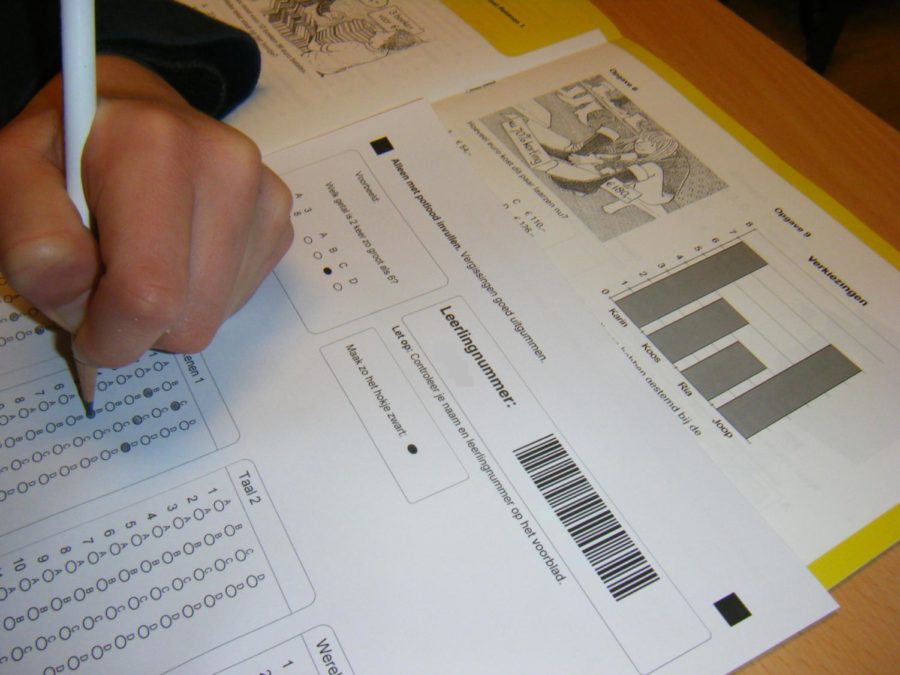What do standardized tests actually measure?
By Onderwijsgek at nl.wikipedia, CC BY-SA 2.5 nl, https://commons.wikimedia.org/w/index.php?curid=6804616
February 6, 2018
I loathe standardized testing. Absolutely despise it. This is coming from someone who tries really hard at academics, who cares a lot (like, a whole lot) about tests, who do well in those types of settings. Standardized testing may be one of the worst parts of academia.
Being forced to sit down and be quiet for up to four hours is just awful and draining, and most students agree. According to The Washington Post, students take an average of 112 standardized tests up to 12th grade. But the biggest, highest stakes, god-tier -level standardized test of them all? The SAT. And the SAT doesn’t just suck as a standardized test. It’s also grossly unfair to lower income and ethnic minority students.
Every year, thousands of high school students prepare to take the SAT. The SAT is considered highly important in many college admissions, and scores are a ridiculously big deal. Thus comes an onslaught of SAT prep classes, SAT help books and Khan Academy for hours on end. If you don’t take an SAT prep class, what are you even doing? The SAT attracts money. The SAT, for many students, decides where they end up going to college. According to CNN, College Board makes $600 million a year, it’s president raking in $900,000 in salary and benefits. This money comes largely from the products being sold on the College Board website to help students with the SAT, along with with the fees to take an SAT test or send test scores to schools.
But is the SAT fair for all students, of all races and classes? According to Inside Higher Ed, the average reading score for black students was 429, which is 99 points below the white students’ average. Research suggests that this discrepancy is attributed to black students living in lower income areas not having access to the same academic privileges that white students do, according to the College Board.
The College Board defends itself by saying that society is unfair, but the SAT is not. This is a weak-willed response to the futures of many black and Latino students being heavily swayed by their SAT scores, scores that can’t possibly compete with the scores of white students who have greater access to prep tools and who are socially encouraged to succeed. Yes, society is unfair, but we shouldn’t just be standing around accepting that. What are we doing as a nation that even standardized testing is racist? Not only do students suffer through them, but many of them are disadvantaged from the very start.
In The Structure of Argument by Annette T. Rottenberg and Donna Haisty Winchell, they write, “If you’re rich, you can buy your kids a high SAT score.” This is essentially true as well: kids living in low-income areas aren’t going to be able to afford SAT help books, study classes, and personal tutoring. That in itself puts their scores at a disadvantage because they’re not accessing the same study tools that upper-class children are.
There is also the idea of “middle-class necessity” found in many standardized test questions that render them unfair. For instance, one question asked which word would go best with “cup.” The options were “wall,” “saucer,” “table” or “window.” The correct answer was saucer, but many students selected table as they did not use saucers for their cups at home. This highlights how the test isn’t necessarily inclusive, even if this question is considered subtle and not highly important. The test assumes that the typical American experience is universal. It is not.
Many argue that the SAT should stay: it can make up for application weaknesses, such as for a student who isn’t great at writing essays. However, many fail to realize that the racially biased results of the SAT are institutionalized. While the SAT may aid a few students to bring up an otherwise lackluster application, it overwhelmingly puts others at a disadvantage. According to Inside Higher Education, only 20% of black students met the SAT benchmark for both math and English, compared to 70% of Asian students and 59% of white students meeting those same benchmarks. Whatever benefits the SAT may carry for a few cannot outweigh the discrepancies that contribute to generational racism.
The most viable solution to this is for colleges to take a stand and to stop making the SAT an integral part of the admissions process. Governments should also consider not making standardized tests such a high priority in public schools and actually begin to fund schools in lower income areas. Give all children a chance. Give all public school students a chance. We can only do so much with what we’re given.



